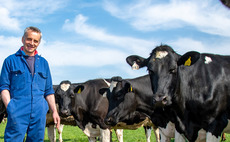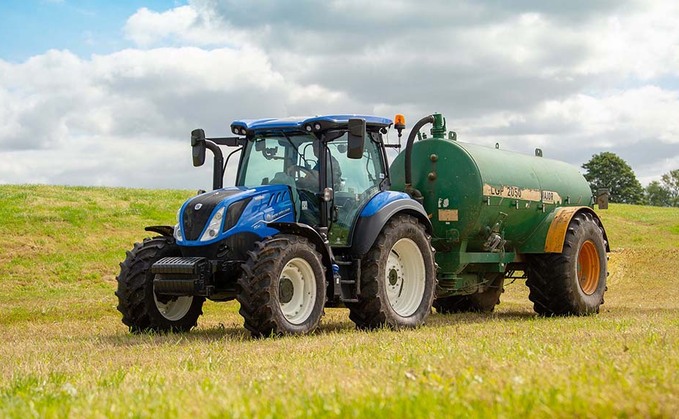
Combining big tractor features in a relatively compact package, we try out New Holland's latest T5 Dynamic Command tractor. James Rickard puts the tractor to work to find out more.
Like many manufacturers, New Holland is currently on a big development push in the 100-140hp tractor segment. And it appears to be a highly valued segment, one which manufacturers are climbing over each other to be a part of. Such tractors include John Deere's new sloping bonnet M6 models, Massey Ferguson's 5700 S Series and Fendt's 300 Series, to name a few.
A key aspect of all these tractors is to have broad appeal, with a wide specification choice to match the equally wide variance in customer base in this segment. As such, New Holland's latest offering, the T5 Dynamic Command tractor series, marries together aspects of its small stature T5 models with features adopted from its larger T6 models.
This includes the incorporation of the T6's 24 by 24 dual clutch Dynamic Command transmission (DCT), its 4.5-litre engine and its four post cab. For all intents and purposes, you could say the new T5 DCT is a replacement for the old short wheelbase T6, a range and size of tractor many customers miss.
This is because, as many tractor manufacturer's ranges have, New Holland's line-up of tractors has ‘grown up' over the years. In 2016, to handle the ever increasing power of the T6 range, to get its power down and improve stability, its wheelbase was lengthened and standardised.
On the four-cylinder T6 models, this saw a spacer placed in between the engine and the gearbox, making its wheelbase the same as the six-cylinder versions.
However, this left a gap between the upper end of the T5 range, which up until recently has been topped by the T5 Electro Command, and the lower end of the T6. This is where the T5 DCT fits in, which is also complimented by the T5 Auto Command which features a continuously variable transmission.
Four models make up the T5 DCT family, ranging from 110 to 140hp (maximum rated). To get a flavour of the range, we tried out the top T5.140 model.
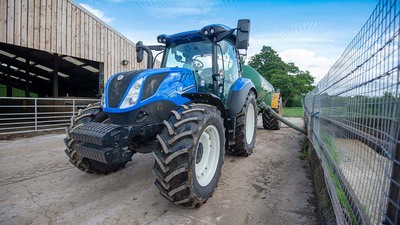
Specifications
- Model: T5.140 Dynamic Command
- Engine: 4.5-litre, four-cylinder, FPT
- Power: 130hp rated, 140hp maximum rated
- Maximum torque: 630Nm at 1,300rpm
- Transmission: 40kph, 24 by 24-speed, dual clutch, semi-powershift
- Hydraulic pump capacity: 110 litres/minute
- Rear linkage lift capacity: 5,500kg
- Wheelbase: 2,490mm
- List price (as tested): £84,458
About DCT
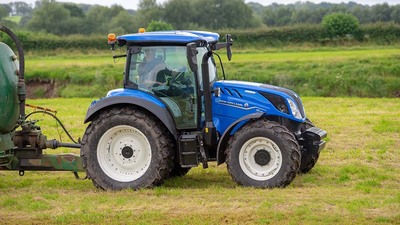
First introduced on the T6, a big highlight of the T5 DCT tractor is the use of the firm's 24 by 24 speed, Dynamic Command transmission, hence the tractor's name. And as the transmission did when we tried it in the T6 (FG, November, 2018), we were just as impressed with it this time.
Essentially, DCT is a modern take on a semi-powershift transmission, designed to offer greater efficiency with fewer parasitic losses along with greater user friendliness. The transmission comprises three ranges with eight gears in each range. Though this may sound similar to New Holland's three-range, 18-speed Range Command transmission, as used in its old 60 Series, TMs and now T7s, it is substantially different in the way it works and what it offers.
DCT's technology is based on the same principals as used in the firm's CVT, which enables fast mechanical range changes. In this instance, those principals are applied to the powershift changes. This sees the tractors' eight powershift gears split between two shafts; odd gears mounted on one, even gears on another. Via a clutch pack on each shaft, power can be routed quickly from one shaft to another.
The results are very fast and very smooth gear changes. It is without doubt one of the best semi-powershifts on the market. Even the range changes do not hang about which are taken care of via a third shaft. Separate clutches also look after shuttling, reducing any delay. Cleverly, the gearbox will also predict whether you are changing up or down and will pre-select the next gear.
Making the most of ‘usable' gears, there is a considerable overlap between low and medium ranges. This means you will have a tendency to stay in one range for a job, rather than having to flick between ranges to get the ideal gear. High range is pretty much reserved for transport, but unlike the larger T6 tractors the T5 DCT is limited to a 40kph top speed. While this is fairly standard for a tractor of this size in the market, it may be an issue for some potential customers. From an economical point of view, at least, top speed can be achieved at 1,600rpm.
DCT operation
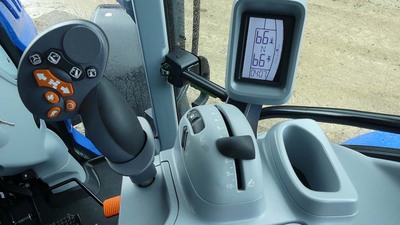
Like many powershift transmissions, DCT can be operated in manual or in automatic. Whether operating in fully automatic or in semi-automatic, whereby shift changes are limited to within a range, the total number of gears used in automatic can also be limited to a selection of your choice. This prevents any unnecessary or unexpected shift changes from occurring - a good idea for draft work.
Skipping ranges is also possible. When this happens gears are speed matched to change to the next appropriate gear. And should you mash the throttle in automatic, a kick down function will see the ‘box drop a gear in reaction to the demand in performance.
Delving deeper into transmission set-up, via the tractor's dash in our case, reveals a whole host of other functions. ‘Smooth Shift' turned out to be a particular favourite, which gives a blip of the throttle when a down shift is made, along with a dip in the throttle when upshifts are made. As the name suggests, this is designed to give a smoother gearshift, while at the same time offer better protection of the transmission. It can be turned on or off, or used in auto which sees it turn off when the pto is engaged.
‘Dynamic Stop/Start' is a useful function too, which, when engaged, will automatically pull the clutch in when the brakes are applied. Clutch disengagement/engagement is progressive too and can be set to one of three levels of aggression. When combined with automatic transmission mode, this allows the tractor to be driven virtually like an automatic car. It is also useful for loader work and when round baling, for example.
Finally, a ‘Memory Shuttle' function allows you to set a difference in gears, by up to three gears, between travelling forwards and backwards. For example, for loader work, you might want a slower gear going forwards and a faster gear in reverse. It will also remember different forward and reverse start-off gears, ideal for when tipping trailers.
And if you specify the IntelliView IV terminal, you can use a scroll wheel on the main control lever to set a target speed. Much like a CVT, ‘Ground Speed Management' will allow you to dial in a speed, leaving the engine and transmission to work out the most appropriate revs and ratios.
Engine
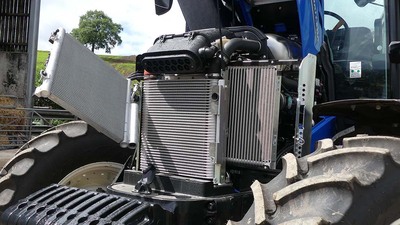
Maximum power levels for the T5 DCT directly relate to the model number, with the rated power figure roughly 10hp less.
Unlike many of the manufacturer's larger models, the T5 DCT has no power boost - what you see is what you get.
Under the bonnet, packaging has been well thought about - wide opening radiator assembly allows really good access. And rather than cram all the after treatment paraphernalia in a canister under the front right hand corner of the cab, as with its other tractors, New Holland has cleverly managed to get it all under the bonnet. This really opens up the area around the front right hand corner of the cab, providing better sightlines with less to catch on gateposts.
However, it will be interesting to find out what this tractor is like with a loader and whether or not the positioning of the after treatment system under the bonnet has any effect on loader visibility. As for emissions, the tractor meets Stage 5 using diesel exhaust fluid (AdBlue).
Rear-end
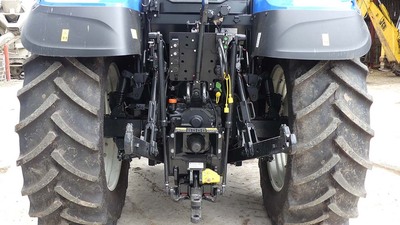
While the engine, gearbox, front axle and cab are adopted from the larger T6, it is the rear-end and hydraulic capability which is more akin with the T5 family. To this end, the T5 DCT gets a 5.5 tonne linkage capacity and a 110 litres/minute closed centre load sensing pump.
Up to four double-acting spools can be specified at the rear, as well as three mid-mount valves for a loader or front linkage. The latter option is capable of lifting 2,250kg. A push back Sauermann pickup hitch is also standard.
Compared to the stature of the T5 Electro Command and Utility models, the T5 DCT is a slightly larger machine. While those two models feature 3.4-litre, four-cylinder engines and wheelbases of 2.38m (Electro Command) and 2.29m (Utility), the T5 DCT with its larger engine and T6-derived gearbox sits at 2.49m. By contrast, the T6's wheelbase is 2.7m.
Unlike the larger T6, the T5 DCT's engine is bolted straight to the gearbox, with no spacer in between, giving the tractor a shorter wheelbase and tighter turning circle.
At the rear, the T5 DCT can be fitted with up to 600/65 R38 tyres. However, because the tractor uses the same cab as used on the manufacturer's larger tractors, it has had to fill the gap between the top of the tyre and the mudguard with a bit of plastic filler. It is quite a neat job and the tractor does look well proportioned with it.
Practicalities
P1
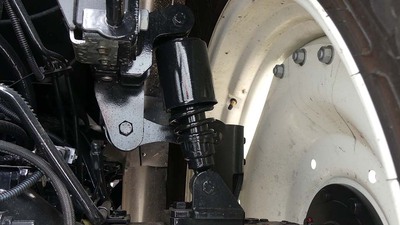
Keeping things relatively comfy, cab suspension is standard and you can also spec front axle suspension.
P2
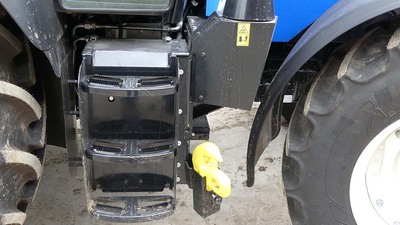
Conveniently, drawbar storage is near the front of the cab on the right hand side.
P3
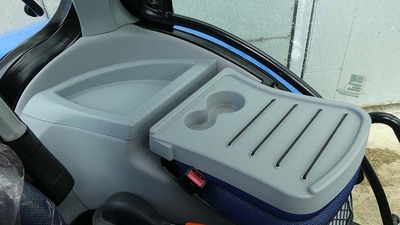
Passenger seat folds down to create a decent amount of flat space.
P4

The standard roof window is useful, but a larger version is available.
Control
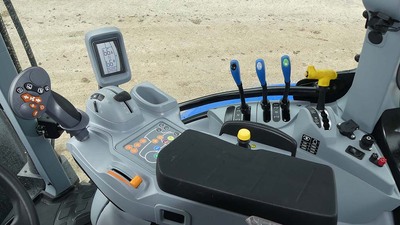
Our T5 DCT featured a relatively base-specification, though it was short of nothing for our needs. Spec included the firm's basic SideWinder armrest control with fixed CommandGrip control lever, its simple Display of Gears screen (DOG screen) and mechanical spool control.
Should you wish greater specification, various options and extras can be added to suit. This includes the firm's top-spec SideWinder II armrest control with electric spool control, its IntelliView IV touch screen terminal and its integrated joystick control over mid-mount valves.
Certainly, the screen would allow greater control and setup over tractor functions, as well as the ability to have automatic steering, IsoBus control and section control. However, you can also mix and match the spec. For example, if you wanted a basic tractor but needed automatic steering and section control for some fertiliser spreading, you could opt for the basic SideWinder with mechanical spools, but instead of the DOG screen, have a touch screen terminal.
As for the main CommandGrip control lever, this puts all primary controls to hand. And, if fitted, features a four-way pad for control over electric spools. Gear changes are easily made by plus and minus buttons on the lever, but you can also specify a moving lever to change through the gears by nudging it forwards and backwards.
As well as by buttons on the stick, direction changes can be made by using a left hand shuttle lever. The latter is a return to centre type lever, meaning it always goes back to its middle position when a direction has been selected, which can catch you out sometimes as there is no physical way to ‘feel' which direction is selected. This said, clear arrows on the dash and DOG screen do show this.
As mentioned, the basic spec will probably have everything you need for 90 per cent of jobs, with much of the tractor's set-up, the transmission in particular, able to be done through the dash. And judging by New Holland dealer feedback, this spec will probably be the most popular for this tractor. It is also quite satisfying being able to grab hold of a spool lever.
Cab
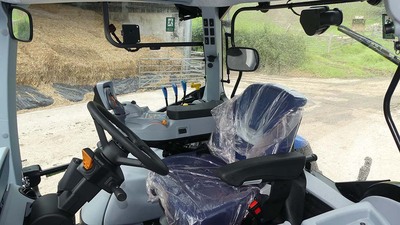
Introduced on the TSA Series back in in 2005, the T5 DCT gets the same cab frame. This is also the same Horizon cab as used on its larger stablemates, right up to the T7.315.
It is a cab which has evolved pretty well over time and it suits the T5 DCT. Though we tend to prefer five or six post cabs for this size of tractor, due to the fact they are much easier to get in and out of for stop/start work, the large doors on this model are not as prone to ‘flopping' about as some other four post tractor cabs.
As a result, access is fairly unrestricted, though it is actually easier to get in and out of the cab with the passenger seat's backrest in the upright position. An adjustable steering column also helps with this and to get in the ideal driving position, but it would also be good if this could be adjusted by pressing a foot pedal rather than a catch under the steering column.
Visibility all-round is decent, though the window wiper could do with covering a little more area. And while our model featured the standard roof window, you can also specify an extra high visibility roof said to be a lot more loader friendly, which also gets a greater amount of window wiper travel.
Cosmetically, the dash has had a few tweaks. Now featuring a black background, it does not sound much but it does make it look a lot more refined.
Verdict
The T5 DCT is a great addition to New Holland's line-up and perfectly fills the gap left behind by the old short wheelbase T6s.
While there is lots of competition in this segment, its compact stature married to big tractor features, primarily the Dynamic Command transmission, makes this tractor stand out in the market. Yes, there are lots of good semi-powershift transmissions out there, but this is head and shoulders above the rest in this class.
As well as its simple operation, the transmission is also packed with lots of useful features which are not there just for the sake of an engineering exercise.
Overall, this tractor and its flexible specification should appeal to a wide customer base. As for its loader capabilities and what some of its other options and extras bring, we look forward to trying these out in the future.













